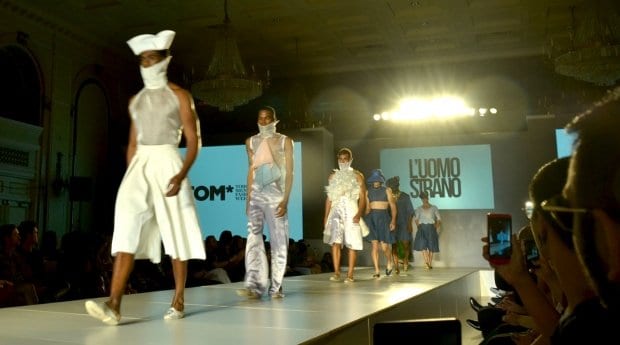After being removed and then reinstated to the TOM Fashion Week lineup, the only drama surrounding Mic Carter’s L’uomo Strano menswear line was of the sartorial variety.
His clothes made their way down the runway Aug 14 at the inaugural men’s fashion show to the applause of the crowd.
“We just jumped back in,” Carter says. The designer claims that the organizers of TOM asked him to make his collection more masculine. He refused, and his show was cancelled on Aug 11.
Carter, who has also shown his work at Fashion Art Toronto, an alternative fashion week, is known for playing with notions of gender. His pieces include androgynous crop tops and voluminous pants and are cut in traditionally feminine fabrics, including lace and silk, alongside denim and “pleather” material.
Jeff Rustia, the executive director and founder of TOM Fashion Week, refutes Carter’s claim that the clothes were rejected because they were too feminine. In a statement provided to Xtra, Rustia said that the quality of Carter’s clothes when presented at a pre-show fitting were not up to their usual quality. TOM organizers also told the Toronto Star on Aug 12 that the clothes were “frayed” and did not meet standards.
However, Rustia said in his statement that after due consideration and in good faith, the organizers of TOM reextended their invitation to Carter to show his collection. Rustia was in attendance at the L’uomo Strano show but was unavailable to answer Xtra’s questions.
Several fashion critics think Carter deserved to show his pieces on the runway for TOM. “I personally didn’t think it was unpolished in a way that it didn’t deserve to be seen,” says Natalia Manzocco, the lifestyle editor at blogTO. “It had something interesting to say. It pushed the boundaries of what men’s fashion really is,” she says, noting that she thinks some of the technical skills displayed by Carter show a lot of promise.
“I agree that I can see why some of it may have been a bit too feminine, but on the other hand, why is that a bad thing?” asks Esther Rogers, writer for Revere magazine. “You see masculine styles and masculine cuts in womenswear shows — why wouldn’t we see the opposite here?”
Erica Chapman, a fashion blogger (who sported lace bunny ears at the event), notes that while the clothing might be hard to style editorially, she loves the collection. “As a woman, I would wear it,” she says.
After Carter’s collection debuted, two other designers featured female models alongside male ones. Pedram Karimi, a Montreal designer, sent models of both genders down the runway in skirts and shorts, some with artfully frayed hemlines.
Carter says that deciding whether he would show the collection after he was invited back was a struggle but that the support of the fashion community encouraged him to go ahead as planned.
He started his show with a monologue about the interplay between genders, a choice, he says, that evolved recently. “I was always really looking for something to play at the beginning, and it seemed like that fit really well,” he says.
In the end, however, the biggest gratification was getting to show his collection. “The pieces looked really fantastic on the dudes, and I think it opened up a really important discussion surrounding gender,” he says.


 Why you can trust Xtra
Why you can trust Xtra


